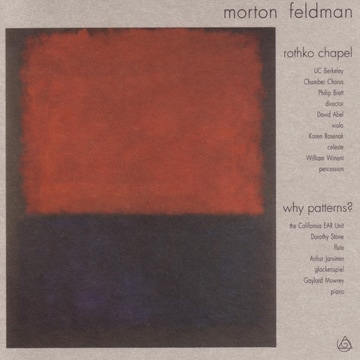|
Rothko Chapel/Why Patterns?
UC Berkeley Chamber Chorus; David Abel, viola; Karen Rosenak, celeste; William Winant, percussion; California EAR Unit Feldman's works of the seventies were less aggressively strange than those of the fifties and sixties. He sought out warmer, simpler chords, bewitching fragments of melody. Music of this period—the viola-and-ensemble cycle "The Viola in My Life"; a series of concertolike pieces for cello, piano, oboe, and flute; the choral masterwork "Rothko Chapel"—provides a good introduction to a sometimes forbidding sound-world. (Rothko Chapel has been recorded immaculately on the New Albion label... --Alex Ross in The New Yorker The Rothko Chapel is a spiritual environment created by the American painter Mark Rothko (1903-1970) as a place for contemplation where men and women of all faiths, or of none, may meditate in silence, in solitude or celebration together. For this chapel, built in 1971 by the Ménil Foundation in Houston, Texas, Rothko painted fourteen large canvasses. While I was in Houston for the opening ceremonies of the Rothko Chapel, my friends John and Dominique de Ménil asked me to write a composition as a tribute to Rothko to be performed in the chapel the following year. To a large degree, my choice of instruments (in terms of forces used, balance and timbre) was affected by the space of the chapel as well as the paintings. Rothko's imagery goes right to the edge of his canvas, and I wanted the same effect with the music - that it should permeate the whole octagonal-shaped room and not be heard from a certain distance. The result is very much what you have in a recording - the sound is closer, more physically with you than in a concert hall. The total rhythm of the paintings as Rothko arranged them created an unbroken continuity. While it was possible with the paintings to reiterate color and scale and still retain dramatic interest, I felt that the music called for a series of highly contrasted merging sections. I envisioned an immobile procession not unlike the friezes on Greek temples. These sections could be characterized as follows: 1. a longish declamatory opening; 2. a more stationary "abstract" section for chorus and chimes; 3. motivic interlude for soprano, viola and tympani; 4. a lyric ending for viola with vibraphone accompaniment, later joined by the chorus in a collage effect. There are a few personal references in Rothko Chapel. The soprano melody, for example, was written on the day of Stravinsky's funeral service in New York. The quasi-Hebraic melody played by the viola at the end was written when I was fifteen. Certain intervals throughout the work have the ring of the synagogue. There were other references which I have now forgotten. --Morton Feldman If there is a Holocaust memorial in Feldman’s work, it is “Rothko Chapel,” which was written in 1971, for Rothko’s octagonal array of paintings in Houston. Rothko had committed suicide the previous year, and Feldman, who had become his close friend, responded with his most personal, affecting work. It is scored for viola, solo soprano, chorus, percussion, and celesta. There are voices, but no words. As is so often the case in Feldman’s music, chords and melodic fragments hover like shrouded forms, surrounded by thick silence. The viola offers wide-ranging, rising-and-falling phrases. The drums roll and tap at the edge of audibility. Celesta and vibraphone chime gentle clusters. There are fleeting echoes of past music, as when the chorus sings distant, dissonant chords reminiscent of the voice of God in Schoenberg’s “Moses und Aron,” or when the soprano sings a thin, quasi-tonal melody that echoes the vocal lines of Stravinsky’s final masterpiece, the “Requiem Canticles.” That passage was written on the day of Stravinsky’s funeral, in April, 1971—another thread of lament in the pattern. But the emotional sphere of “Rothko Chapel” is too vast to be considered a memorial for an individual, whether it is Rothko or Stravinsky. Shortly before the end, something astonishing happens. The viola begins to play a keening, minor-key, modal song, redolent of the synagogue. Feldman had written this music decades earlier, during the Second World War, when he was attending the High School of Music and Art, in New York. Underneath it, celesta and vibraphone play a murmuring four-note pattern, which calls to mind a figure in Stravinsky’s “Symphony of Psalms.” The song unfurls twice, and the chorus answers with the chords of God. The allusions suggest that Feldman is creating a divine music, appropriate to the somber spirituality of Rothko’s chapel. In a sense, he is fusing two different divinities, representative of two major strains in twentieth-century music: the remote, Hebraic God of Schoenberg’s opera, and the luminous, iconic presence of Stravinsky’s symphony. Finally, there is the possibility that the melody itself, that sweet, sad, Jewish-sounding tune, speaks for those whom Feldman heard beneath the cobblestones of German towns. It might be the chant of millions in a single voice. from the essay, American Sublime, by Alex Ross in the New Yorker http://www.newyorker.com/magazine/2006/06/19/american-sublime Available here: iTunes HDtracks |
New Albion Records, Inc.Archives
October 2010
|


